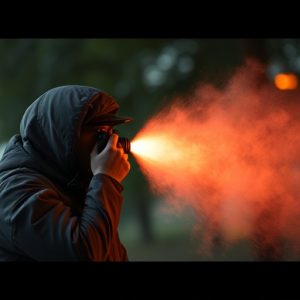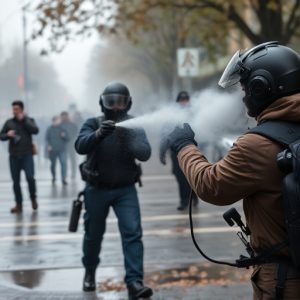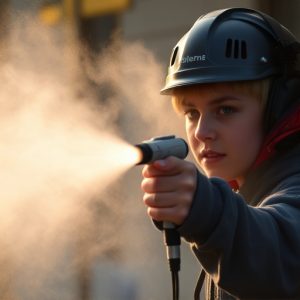Decoding Spray Distance: Impact on Self-Defense and Vision Effects
Pepper spray is an effective self-defense tool that relies on precise deployment for optimal effect…….
Pepper spray is an effective self-defense tool that relies on precise deployment for optimal effectiveness. Its primary active ingredient, oleoresin capsicinoid, causes intense irritation to the mucous membranes upon contact, leading to temporary vision impairment. The spray's range from 3 to 12 feet is critical; users must stand between 0.5 to 2 meters away from an assailant to avoid harming themselves or contending with environmental factors like wind. Pepper spray can cause capsaicinoid dermatitis, which is a temporary inflammation of the skin, and while it can induce symptoms resembling 'blindness,' it does not typically cause permanent vision loss. However, prolonged exposure or improper application can result in serious eye injuries. The effects of pepper spray are largely temporary but can vary based on concentration, duration, and individual sensitivity. Proper training is essential for users to effectively employ this tool while ensuring their safety and the safety of those around them. Understanding how environmental conditions affect the spray's trajectory is key to its successful use as a deterrent in self-defense scenarios.
When considering personal safety, understanding the capabilities and limitations of self-defense tools is paramount. This article delves into a critical aspect of pepper spray usage: its spray distance. Exploring how far pepper spray reaches and its impact on assailant vision can be pivotal in self-defense scenarios. We’ll examine the science behind pepper spray, addressing concerns such as whether it can cause temporary or permanent blindness, and identify factors that influence its effectiveness. Key considerations like wind conditions, aiming techniques, and spray concentration will also be highlighted to ensure you are fully informed on the use of this vital self-defense tool.
Understanding Spray Distance and Its Impact on Self-Defense
Spray distance is a critical factor to consider when using pepper spray for self-defense. The effectiveness of the spray in incapacitating an assailant hinges on its delivery within an optimal range. Typically, pepper spray is designed to deliver a powerful concentration of oleoresin capsicoid, the active ingredient responsible for inducing intense irritation upon contact with the mucous membranes. The spray’s distance must account for the assailant’s proximity and the environment where the incident occurs. Failing to recognize the appropriate spray distance can render the pepper spray ineffective or unsafe. For instance, if the spray is deployed too far away, it may not reach the attacker, while deploying it at a distance that is too close could result in the spray returning towards the user, potentially causing injury.
Understanding the factors affecting spray distance, such as wind conditions and the angle at which the canister is held, is essential for ensuring the spray reaches its intended target. The psychological impact of pepper spray should also be considered; a well-placed burst can cause immediate blindness or impaired vision, allowing for a safe escape from a dangerous situation. It’s important to recognize that while the question “Can pepper spray blind you?” often arises in discussions about self-defense sprays, the term “blind” may be an overstatement. However, the intense irritation to the eyes can significantly impair vision long enough for a person to retreat to safety. Therefore, when considering pepper spray as a self-defense tool, understanding its spray distance and the conditions affecting its trajectory is paramount to maximizing its defensive capabilities.
The Science Behind Pepper Spray: How It Affects Vision
Capacitance pepper sprays are formulated with oleoresin capsicoid, a compound responsible for inducing irritation upon contact with mucous membranes. The spray’s distance capability is a critical factor in its effectiveness and safety; it determines the extent to which the irritant can be delivered. Typically, pepper sprays have a range that can extend from 3 to 12 feet, allowing users to protect themselves from a safe distance. Upon discharge, the fine particles of the spray travel through the air and quickly reach the eyes of an assailant, causing intense burning and blurred vision, which can temporarily impair their ability to see, potentially preventing them from effectively continuing an attack.
The impact of pepper spray on vision is both rapid and potent. It acts by stimulating the trigeminal nerves that are closely associated with the eyes, nose, and mouth. The active ingredients in the spray bind with these receptors, triggering a cascade of neural signals that the brain interprets as extreme pain. This reaction can lead to lacrimation (tearing), conjunctival redness, swelling, and mucous production, all of which contribute to a significant decrease in visual acuity. The effects are generally short-lived but can last up to 45 minutes, depending on factors such as wind conditions and the individual’s exposure time. It is important to note that while pepper spray can temporarily blind an assailant, it should be used responsibly as a deterrent in self-defense situations. Understanding the science behind its action on the eyes allows users to employ this tool effectively and safely.
Can Pepper Spray Cause Temporary or Permanent Blindness?
Exposure to pepper spray can result in a range of temporary discomforts, with effects that vary depending on the concentration of the spray, the duration of exposure, and individual sensitivity. While the primary effect of pepper spray is irritation to the eyes, skin, and respiratory system, causing a temporary inflammation known as “capsaicinoid dermatitis,” the severity can lead to a condition resembling chemical burns. The effects are generally reversible upon washing the affected areas with water and receiving medical attention. However, in extreme cases or if proper decontamination measures are not taken promptly, the irritation may persist longer than usual. The question of whether pepper spray can cause permanent blindness is a complex one. Permanent blindness from pepper spray exposure is rare; it typically does not damage the eyes in a way that leads to long-term vision loss. However, prolonged exposure or the use of pepper spray under certain conditions could potentially lead to corneal abrasions or other serious eye injuries if not treated appropriately and promptly. It’s crucial for individuals affected by pepper spray to seek immediate medical attention to minimize the risk of complications that could lead to more severe outcomes. Understanding the potential impact of pepper spray is essential for both law enforcement and civilians who might encounter it, as knowledge of its effects can inform proper safety measures and effective response strategies.
Factors Influencing the Effectiveness of Pepper Spray in Self-Defense Situations
The effectiveness of pepper spray as a self-defense tool is influenced by several critical factors, which include the spray distance from the target and environmental conditions. When considering whether can pepper spray blind you temporarily, it’s essential to understand that the oleoresin capsicin in the spray irritates the eyes, causing extreme discomfort that can lead to temporary blindness. The intensity of this effect is contingent upon the proper deployment of the spray, which requires aiming at the assailant’s face from an optimal distance—typically between 0.5 to 2 meters away. Factors such as wind direction and speed can significantly impact the spray’s trajectory and efficacy, potentially reducing its potency or even causing it to harm the user if not used correctly. Additionally, individual differences in sensitivity to the spray’s active components can alter the outcomes, with some individuals experiencing more severe effects than others. Therefore, for maximum effectiveness, users must be trained in the proper use of pepper spray, understanding that accuracy and correct dosage are key to effectively deterring an attacker without posing undue risk to bystanders or oneself. Environmental factors such as lighting conditions and the presence of barriers can also affect the spray’s performance, further underscoring the importance of skillful deployment in self-defense scenarios.


